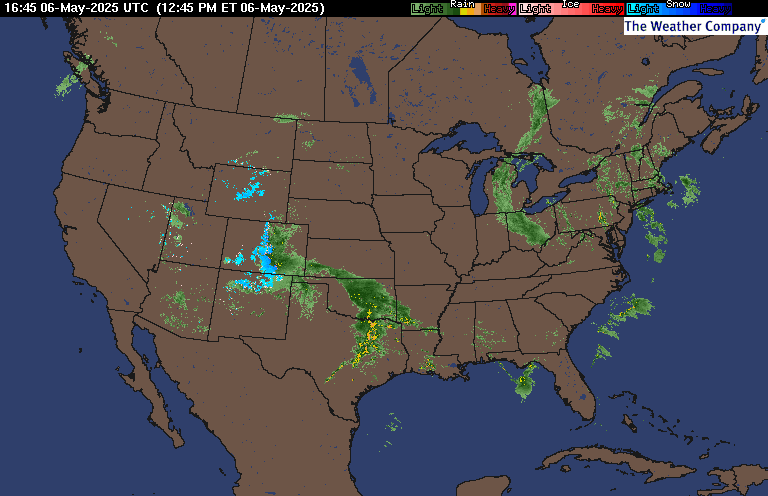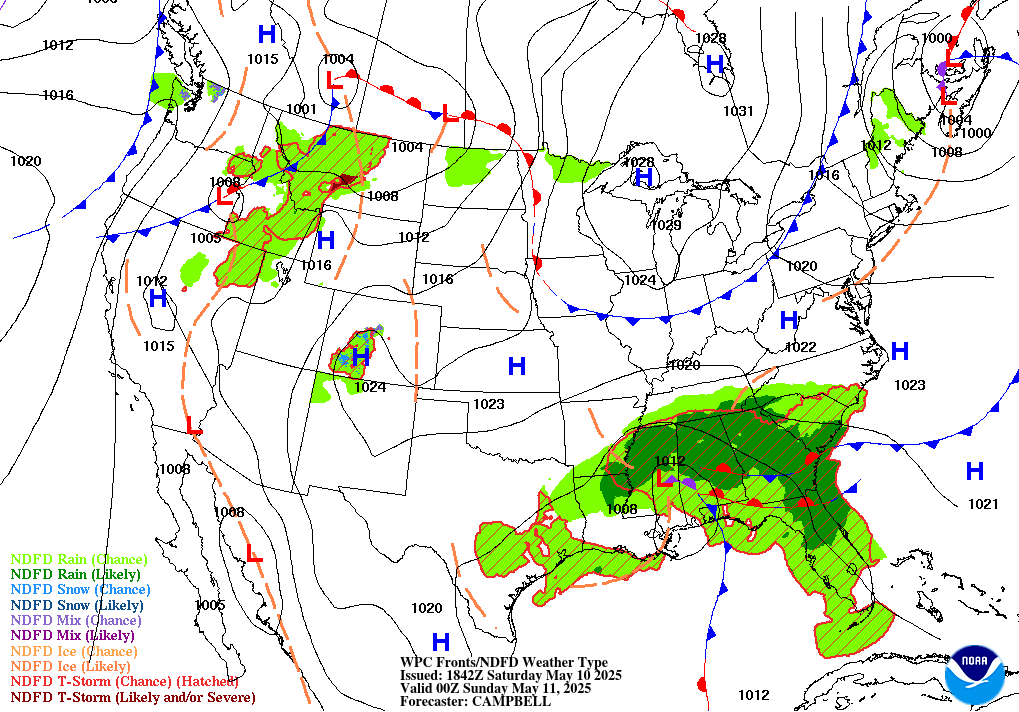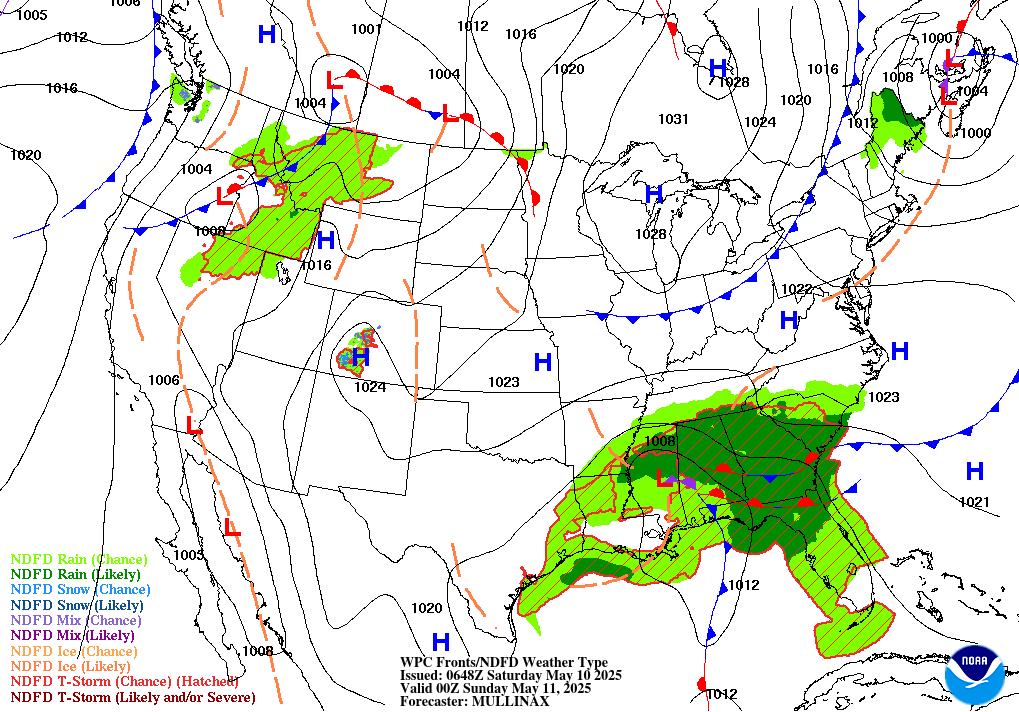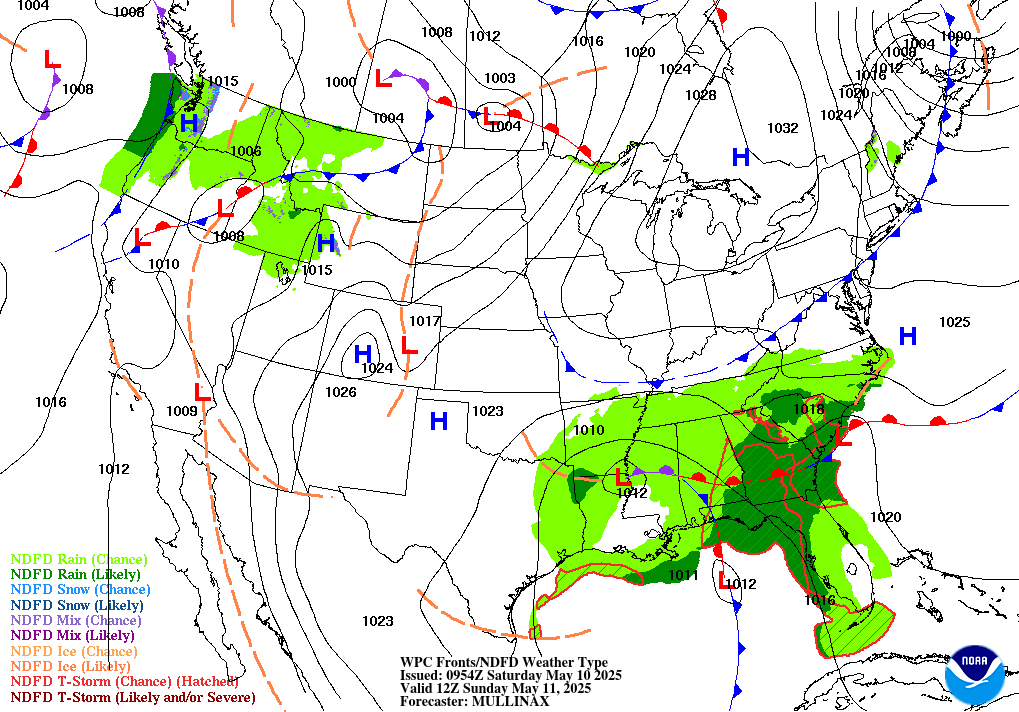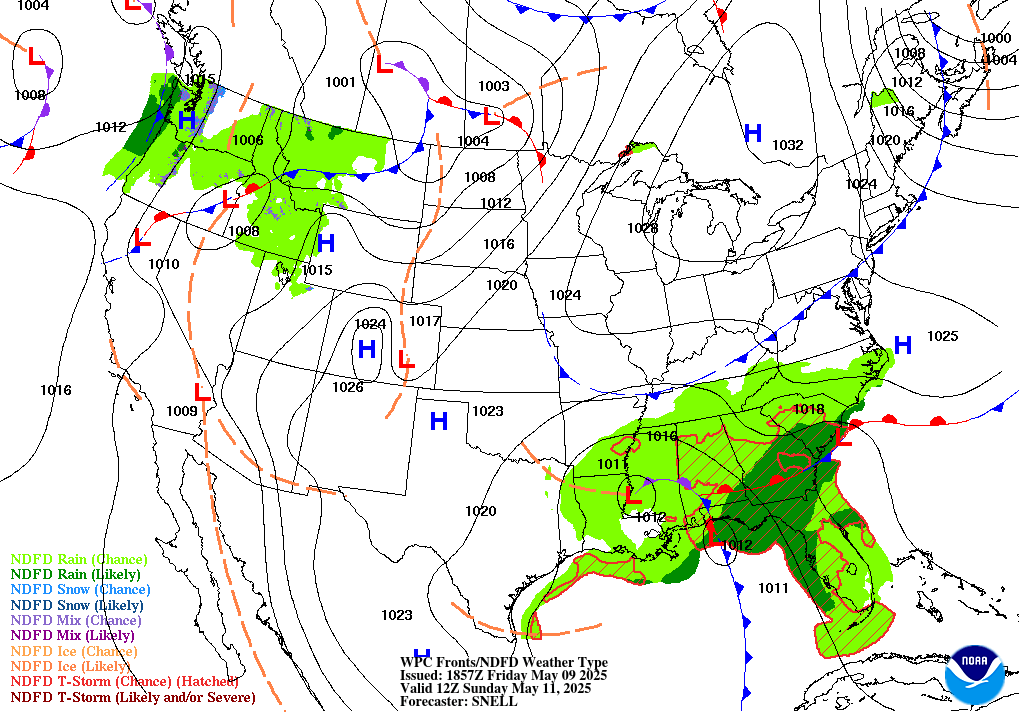General
The National Weather Service
offers forecasts, analysis tools, watches, warnings, outlooks, climate data,
education, and more for the U.S.
The Storm Prediction Center
offers official convective outlooks, discussions, watches, warnings, and more
on their website for severe weather.
The Weather Prediction
Center offers outlooks of general surface analysis forecasts and national
precipitation forecasts.
The National Hurricane
Center offers outlooks and tools for the tropics.
The Climate Prediction
Center offers long term outlooks for the U.S. including weekly, monthly,
and seasonal forecasts.
The Space Weather Prediction
Center offers space weather analysis and forecasts.
Computer Models
General
Pivotal Weather: For
those who are looking for an easy to use and beautiful graphical interface.
Very smooth and visually appealing maps is offered here. There are national and
regional views, which makes this website stand out from others as well. The
ECMWF, GFS, GGEM, HRRR, NAM, 4km NAM, RAP, and RGEM are available here. Ease of
use is relatively easy. There is also detailed forecasted model skew-t's
offered here, using SHARPpy, a big bonus.
College of DuPage:
For those who are looking for an easy to use, quickly updating website.
Overall, this is a very solid website with several parameters as well as above
average graphics. There are national and regional views. The wind barbs /
streamlines are highly detailed on this website. Ease of use is relatively
smooth. Several models are available here, including the HRRR, RAP, NAM, 4km
NAM, SREF, GFS, GEFS, ECMWF, and CFSv2 models are offered here. However, the
GEM is not included. There is also detailed forecasted model skew-t's offered
here, using SHARPpy, a big bonus.
Twister Data: For
those who are forecasting severe weather setups. This website has been
around for several years and for its time when it was launched, had great
graphics. Several severe-weather parameters are offered here, along with the
moisture/temp + wind barb overlay. It is simple and easy to use as well. The
RAP, NAM, and GFS are offered here. There are also model-forecasted soundings
and hodographs.
Tropical
Tidbits: For those who want great graphics and several different model
choices. This website offers several different models including the GFS,
EURO, CMC, NAVGEM, HWRF, HWRF-P, GFDL, GFDL-P, NAM (32km, 12km, 4km), WRF-ARW,
WRF-NMM, RGEM, HRRR, CFS, CanSIPS, NMME. There is also ensemble data offered
here, including the EPS, GEFS, and GEPS.
NCEP: For those who are conventional. The National
Weather Service offers some of the American models on their website, including
the GFS, NAM, Hi-res NAM, WRF, RAP, HRRR, & SREF. There are mostly national
views, however there are some regional views as well. The ease of use is
average and the graphics are average as well. However, the graphics are overall
clean and have been around for quite a while for users that are familiar to
these.
Penn State
eWall: For those who want to get lost in a sea of endless data and for
those who want to compare different model parameters. This website is a
smorgasbord of computer model / ensemble, satellite, and radar data. There are
several parameters offered on this website and many different variations of
these parameters. The GFS, NAM, HRRR, CMC, NAVY, and EURO and other models are
offered here. The website design is extremely messy, however, if you are the
type that likes to get lost and explore, this website is for you. Their 4-panel
model charts on here are nice to compare different parameters side by side.
This website also offers ensembles.
WxCaster:
For those who are looking for forecasted snowfall data. This website has
a jumble of different things. Overall the website design is poor, however there
are some things here that are locked up here better than anywhere else. This
website is predominately good for model forecasted snowfall. There are other
things offered here as well, including meteograms, skew-t's, and other tools
and parameters.
Wundermap:
For those who are looking for beautiful, high resolution graphics and
overlays. A beautiful graphical interface with a radar overlay on top of a
map where you can pan and zoom in is offered here. Current conditions and
analysis are also offered. The European computer model looks great on this
website and there are many parameters for this model here, not readily found
elsewhere. Due to the graphical interface, the website has a tendency to lag a
bit, however. It is also lacking some parameters, especially for short range
models.
FSU: For those
who are looking for colorful, bigger picture view of weather patterns. This
website offers an overall good graphical interface with different parameters
examining about half the northern hemisphere, centered around the Atlantic.
This view is good for examining large scale weather patterns.
UCAR: For the
conventional type. Also for those who want to examine clouds at different
layers. This website has been around for a while, and so have it's graphics
and overall design. The NAM and GFS are offered here with a few different
variables for each model.
NSSL 4km WRF: For those
who are looking for several parameters of high res model data. The 4km
WRF's home. Several different parameters are offered for the 4km WRF on this
website, perhaps more than any other website. The overall ease of use is
average.
Washington: For those who are tracking systems coming
onshore of the western U.S. Not only is this website useful for folks
examining the weather in the Pacific Northwest, it is also useful for examining
storm systems and weather patterns in the eastern Pacific Ocean which can tell
a lot on how the weather evolves for the rest of the country. The graphical
interface and detail is relatively nice on here.
NCEP DGEX:
For those who are looking for a unique model / another perspective. This
website offers a model called the DGEX. It is essentially the NAM model
extended to 192 hours. The NAM goes out to 84 hours and then the GFS takes in
the NAM's data at 84 hours and pulls it's data into the GFS algorithms which
are then used to forecast to 192 hours. Ease of use is average.
Colorado State: For those who want to compare model
forecasted parameters with 4-panel charts. These are nice to view different
parameters side by side. The graphics and the website are overall good.
Ensembles
Penn State
eWall: For those who want to get lost in a sea of endless data and for
those who want to compare different model parameters. This website is a
smorgasbord of computer model / ensemble, satellite, and radar data. There are
several parameters offered on this website and many different variations of
these parameters. The GFS, NAM, HRRR, CMC, NAVY, and EURO and other models are
offered here. The website design is extremely messy, however, if you are the
type that likes to get lost and explore, this website is for you. Their 4-panel
model charts on here are nice to compare different parameters side by side.
This website also offers ensembles.
Tropical Tidbits: For those who want great graphics and
several different model choices. This website offers several different
models including the GFS, EURO, CMC, NAVGEM, HWRF, HWRF-P, GFDL, GFDL-P, NAM
(32km, 12km, 4km), WRF-ARW, WRF-NMM, RGEM, HRRR, CFS, CanSIPS, NMME. There is
also ensemble data offered here, including the EPS, GEFS, and GEPS.
SPC SREF: For
those who are looking for different model ensemble data blended together into
one model. This model generates a blended forecast based off several member
runs of other models. This is a good forecasting tool to add to your toolbox
for forecasting all types of weather.
SPC SSEO: For
those who are looking for different model ensemble data blended together into
one model for examining severe thunderstorms. This model generates a
blended forecast based off several member runs of other models. This is a good
forecasting tool to add to your toolbox if you are forecasting severe
thunderstorms. This model may become more and more popular into the future as
we begin to examine specific storms and forecast their specific behavior rather
than "if its going to storm or not".
WPC Snow Accumulation Probabilities: For those who are
looking for a forecasted ensemble of snowfall accumulation. This is a
pretty handy and overall pretty accurate tool. There are probabilities offered
that indicate how likely snow of a certain value (ex. 2 inches or greater, 4
inches or greater, 6 inches or greater) will fall in a specific location.
Google maps are overplayed with an overall good graphical interface.
Unique and Customizable
Plymouth:
For those who want to customize. This website offers a unique capability
where you can customize your model data. This includes customizing parameters,
graphics, overlays, regions, time period, etc. Overall the website design and
ease of use isn't great, but the customizable features offered is the best of
its class.
FNMOC: For those who are looking to examine ocean weather
and aviation weather. Several parameters use to examine waves / oceanic
weather, and aviation weather are offered on this website. There are many
different regions offered around the world.
University of Wyoming: For those who are looking for
customization and overlays. Similar to Plymouth, this website allows you to
customize your maps in terms of stacking multiple parameters on top of each
other. One thing that is nice about this website is the streamlines / wind barb
features offered here, as well as several different parameters offered. It
takes a bit of experimentation but can be useful once one gets the hang of it.
NCEP Low Tracking: For those who want to analyze
forecasted low pressure system tracks. This website is a unique tool to add
to your forecasting tool box. It offers forecasted surface low tracks with
lines showing where the low pressure systems are forecasted to go. There is
also a multi-model field section to see what different models are forecasting.
Washington: For those who are tracking systems coming onto
shore of the western U.S.
ARL:
For those who are looking for customizable forecasting tools. This
website offers several different customizable forecasted model soundings,
meteograms, and other tools for several different areas. Overall ease of use is
relatively easy and they send you a PDF of your requested output.
ISU Meteogram Generator: For those who are looking for
specific data, for specific times, for specific locations. This website
lets you view model-forecasted parameters such as temperature, wind, moisture,
precip amounts, precip type, etc. for specific locations. You can view text
data as well as graphical data on here. This website is relatively easy to use
once you get the hang of it.
Wx Maps: For those who are
looking for beautiful graphical data for specific parameters, for a specific
time, for a specific location. They also have beautiful model graphics and
several different views around the world. Similar to the ISU meteogram
generator website, this website allows you to view meteograms from different
models and time periods for some of the major cities in the U.S. They have a
unique pressure visualization feature through time on the meteogram. The
graphics are pretty good on here and ease of use is very easy.
Observational Analysis
General
SPC Mesoanalysis:
This is an essential for viewing current data. Literally everything you need is
on here, including current obs, radar, satellite, parameters, forecasted
parameters, and even some climatology. You can accomplish some deep analyzing
on here.
SPC
Mesoanalysis Composite: It is essentially the same thing as the regular
mesoanalysis page, however here you can overlay multiple layers on top of each
other.
UCAR: Several
observational tools are offered here, including: surface data, upper air data,
radar, satellite, soundings, and more. I personally like the surface charts
made on this website.
Intellicast: Radar,
satellite, watches/warnings, local weather reports, and beautiful maps are
offered here.
College of DuPage: High
quality radar and satellite graphics and features are offered here. There is
also a small meso-analysis section for deeper analysis.
SPC Upper Air:
You can retrieve the Storm Prediction Center's upper air maps here. They also
offer printer-friendly maps. Another unique feature on this page is that you
can view upper air maps dating all the way back to 1998.
SPC
Soundings: View official observed soundings from the Storm Prediction
Center here. You can view previous soundings a few days back.
NWS
Watches / Warnings: View text products of current watches and warnings
across the country.
NHC: View observed weather
data in the Atlantic Ocean for tropical systems analysis and forecasting via
the National Hurricane Center.
UNL Drought Monitor:
View current drought strength via the University of Nebraska-Lincoln.
AHPS: View
hydrologic data including precipitation, river observations, air quality, and
radar.
Hi-Res Wind Map: View
beautiful streamlines of surface winds of the U.S.
Mesonet: View colored wind speed map of the U.S.
Radar
Wunderground: This is one of the best free radar tools online
out there. There are national, regional, and local views with many different
options and capabilities.
NWS: The National Weather
Service has a solid radar platform on their website with an extremely large
national view, regional views, and local views.
Intellicast: There is a decent radar with different views on this website,
including precipitation type.
College of DuPage:
There are some really handy features on here, including hi-resolution radar and
satellite data, with several different regional views. You can also overlay
parameters and other features on top of the radar / satellite. This is great
for nowcasting, especially for severe weather.
Satellite
College of DuPage:
There are some really handy features on here, including hi-resolution radar and
satellite data, with several different regional views. You can also overlay
parameters and other features on top of the radar / satellite. This is great
for nowcasting, especially for severe weather.
Aviation
Weather: A nice and simple interface is offered here where you can pull up
regional views of satellite. You can view visible, infrared, and water vapor
images.
NOAA GOES: You can view
national and oceanic views around the U.S. with several different resolutions
and product types. Good for examining troughs and tropical weather.
NHC: The
National Hurricane Center offers several different regional and product
satellite variations for the tropics.
CSU: CSU offers several different satellite types and
resolutions, including occasionally a 1-minute interval satellite with very
high resolution.
NASA: Global and
regional views are offered here. Visible, infrared, water vapor, and many
different options for each image are offered here.
Tropical
Ocean Weather:
You can view current ocean conditions for many different tropical regions
throughout the world.
NDBC: The
National Data Buoy Center offers buoy data across the world.
NHC: The National Hurricane
Center offers analysis products as well as reports, watches, and warnings
across the eastern Pacific and Atlantic oceans.
Tropical
Tidbits: There are a few different ocean / oceanic air space analysis tools
offered here with good graphics.
CPC: The Climate Prediction Center offers current and past
analysis of teleconnections. Use this to analyze oceanic temperatures and their
influence on weather patterns.
Aviation
Aviation Weather:
NOAA's Aviation Weather Center offers several analysis tools, forecasts, and
more.
Wunderground
Aviation: There are a few different aviation weather maps with good
graphics on here.
US Air
Net: This website offers detailed graphical forecast for time periods
tailored to aviation-related sports and enthusiasts.
Snow/Ice Pack
NOAA
NATICE: Icepack analysis is offered here.
The Cryosphere Today: Icepack analysis is offered here.
NSIDC: The National Snow and Ice
Data Center offers snow and ice analysis.
Arctic Sea Ice News
and Analysis: Part of NSIDC's offering above, this page has an excellent
analysis of Arctic and Antarctic sea ice.
NOAA NOHRSC:
Snowpack analysis is offered here.
Space Weather
SWPC: The Space Weather
Prediction Center offers space weather forecasts and analysis tools.
SWPC Enthusiasts Page: The Space Weather Prediction Center
has a dashboard styled page geared towards space weather enthusiasts.
Space Weather: This is
a good website to view space weather news, reports, and submitted photos.
Space Weather Live:
There are space weather analysis and forecasts on this page with good graphics.
SpaceW Plots: You can
view plots and sun data on this website for forecasting/nowcasting auroras.
Other
Seismic Monitor: View
seismic activity and earthquakes around the world here.
Moon Phases:
View past, current, and future moon phases here.
Climate Analysis and Forecasting
NOAA Climate: This is a
good go-to resource for pretty much every area of climate analysis and
forecasting.
Climate Prediction
Center: This is a good resource to view temperature and precipitation
forecast anomalies for the next several days, weeks, and months.
CPC Teleconnections: View current and past sea surface
temperatures in different regions of the oceans, including AO, NAO, PNA, and
AAO observations and forecasted outlooks.
NASA Earth
Observatory: View global maps of current air pollutants.
SPC
Sounding Climatology: View specific parameter averages for specific regions
for different times of the year.
SPC Severe Weather
Climatology: You can view several different maps and graphs of tornado,
hail, wind averages and anomalies throughout the U.S.
NCDC:
The National Centers For Environmental Information offers a significant amount
of data and recent reports of the climate.
AHPS: View
precipitation averages and anomalies for the U.S.
SPC Tornado
Outbreaks: This is a really interesting page if you want archived data,
forecasts, and media to analyze previous tornado outbreaks across the U.S.
Archived Data
SPC Storm Reports and
Outlooks: View past storm reports, outlooks, and discussions.
SPC
Mesoanalysis: View past mesoanalysis data. Regional archives dating from
2004-2015 can be found here.
Red
Team Wx: View past regional mesoanalysis data.
CSU: Colorado
State has several different archived maps on this website.
UCAR: View
past surface, upper air, radar, and satellite conditions.
NSSL: View archived processed
radar data and analysis.
NCDC Nexrad:
You can search for virtually any type of radar data for any region going back
several years. Select what type of data you want and they will send you a file
you can import into the NOAA Toolkit program.
NCDC NOMADS: Here you
can find archived model forecast data.
NCDC Climate
Data: There is a good amount of climate data on this website.
Iowa State IEM
Cow: View past warning and storm report data here by searching for
locations, time periods, and storm report types.
NCDC NOMADS: Here you
can find archived model forecast data.
SPC Upper Air:
View historical upper air data here.
Wyoming Sounding and
Upper Air: View archived soundings and upper air data here.
SPC Tornado
Outbreaks: This is a cool page to view historical tornado outbreak
analysis, reports, forecasts, media, and other data across the U.S.
Forums
Weather Decoded Live
Chat: They offer a live chat where you can connect with other weather
enthusiasts and ask questions.
American Wx: Probably the
largest weather forum out there with all sorts of discussions going on.
Accuweather: A rather large forum with several topics going on.
Storm Track: A large severe
weather/storm chasing related forum.
Talk Weather: A good weather forum with a moderate amount of
activity.
The Weather Forums: A
good weather forum with a moderate amount of activity.
Space
Weather Live: A weather forum for space weather enthusiasts.
Software and Apps
General
Allison House: You
can retrieve a bunch of analysis data including observations, radar, lightning,
mesoanalysis, SPC, and other data. You can integrate this data with other some
other software platforms.
SimuAwips: View model,
radar, satellite, lightning, text bulletins, and analysis data.
Weather Decision Technologies:
There are several different software packages and services offered on this
website.
Models
HazWx: Beautiful graphics overlaid
on a Google Maps type interface. Several different models and different
packages to choose from.
American
Wx: American Wx offers their own suite of models with nice graphics.
Weather Bell: A nice
suite of models with very nice graphics are offered here, including extended
European model features.
Radar
GrLevelX: Stunning radar graphics
and a palette of radar analysis features are offered. Different packages/prices
available.
Weather Studio: A radar platform
with great graphics and several analysis and model overlay features.
Radar Lab HD: A simple design with many different radar
analysis features with great graphics.
Weather
Defender: Broadcast TV styled radar graphics and features.
RadarScope: A really sleek
and easy to use radar platform. This platform works with Apple and Android
products.
Educational
Storm Spotting
As a storm spotter, your responsibilities would include observing weather
patterns and cloud conditions from your home as they build in the sky.
Observing the weather can be fun and entertaining, but you will also be helping
local authorities in your area by reporting the weather conditions that you
see. Becoming a storm spotter typically involves taking a class to learn about
meteorology, weather, and storms. Classes also provide guidance about storm
safety and how to report weather events to authorities. Once you have received
training, you can begin using your skills to observe and report the weather.
Providing accurate reports of weather is an integral part of a storm spotter's
job. Even seasoned storm spotters will find room for improvement as they work
to observe the weather. With practice and attention to detail, your accuracy
will develop and you'll notice improvement. Your reports can provide important
information about current weather conditions that can help keep other people
safe.
Weather Spotter's Field Guide: The National Oceanic and
Atmospheric Administration has published this information about the nation's
weather spotting program and how weather spotters do their jobs.
Skywarn Storm
Spotter Program: Learn about the U.S. Skywarn Storm Spotter Program, which
helps authorities get up-to-the-minute news about storms.
About Skywarn: Storm
spotters working with Skywarn are responsible for identifying and describing
local storms to authorities.
Severe Weather
Safety Guide: Storm spotters follow a safety guide while observing weather
to ensure their safety.
Storm Chasing
FAQs: Storm spotting and storm chasing are two different activities. Storm
spotters generally remain at their home location to observe weather, while
storm chasers travel to observe storms.
Identifying The
Different Types Of Storm Clouds: Learn about the different types of clouds.
Storm Spotting and Public Awareness since the First Tornado
Forecasts of 1948: Experts with the National Oceanic and Atmospheric
Administration are the authors of this document, which explores the history of
storm spotting.
Forecasting
Severe Weather Events: Peruse tips and information about forecasting severe
weather, including what to look for as clouds move overhead.
The Storm Spotter's Checklist: The National Weather Service
in Fort Worth/Dallas, Texas, offers a comprehensive checklist for storm
spotters to use, including severe storm characteristics and safety tips.
Storm Spotter Protocol: A local municipality shares its storm
spotter protocol, including how storm spotters work to observe and report
weather conditions.
Spotter Dos and Don'ts: This list of tips helps storm
spotters learn what to do and what not to do as they watch changing weather
patterns.
A Supercell
Storm Cloud Forming over Wyoming: NASA shares a video time lapse of a
supercell storm cloud forming over Wyoming to show how some storm clouds form.
Severe Weather
General
Staying Safe Outdoors in Severe Weather: Learn how severe
weather forms, and learn about staying safe in thunderstorms, blizzards,
tornadoes, hurricanes, floods, hailstorms, and earthquakes.
How to Stay Safe While Driving: This guide prepares people
for exactly what to do when driving in various bad weather conditions,
including if you're caught driving near a tornado.
Disaster Safety and Prevention: Protecting Your Home and Family:
This guide provides advice and resources on securing your house against damage
from acts of nature, as well as considerations to keep in mind for special
audiences like children, seniors, pets, and people with disabilities.
Preparing Your Home For Disaster: This article breaks down
every type of disaster that could happen to you and your home, explaining what
the disaster is, how likely it is going to happen to you depending on where you
live, and what you can do to prepare your home.
Emergency Preparedness Checklist: This well-detailed guide
gives a number of emergency checklists, with some informative videos.
Medication Disaster Plan: Keeping a clear head and placing
safety first is easier said than done when disaster strikes. This guide was
created to educate people on medical emergency preparedness best practices.
Ultimate
Guide to Disaster Preparedness on a Budget: This guide will show you how to
prepare for disasters without having to break your wallet.
Emergency Plan for
a Natural Disaster for Cancer Patients: Making an emergency plan is important
for cancer patients and their caregivers. Prepare a plan before a disaster to
protect your family and their health.
Tornadoes
Home
Safety Preparedness for Tornadoes: Tornadoes are violent forces of nature
in the form of destructive rotating funnels of air. Spawned by thunderstorms,
these columns extend downward and can cause major damage to homes and buildings
as well as destroy an area's infrastructure.
Learn About
Tornadoes: People who live where tornadoes occur should learn about these
storms for optimal safety.
Hurricanes
The Complete Guide to Hurricane Safety: This guide shows how to prepare for
a hurricane and gives tips on what to do during and after the hurricane.
Hurricane
Guide - What You Need to Know: This guide contains everything someone needs
to know about hurricanes, including things people never even think about.
Floods
Flood Safety and
Preparedness Guide: No one wants to suffer a flood, but it's an unfortunate
reality more often than we might think. This guide will show you how to prepare
for a flood, the actions you should take during a flood, and also what you
should do in the days afterward.
Flooded
Basement: What To Do: This is a full guide on basement flooding, its
sources, how to handle cleanup, and how to prevent a wet basement problem from
occurring again.
Thunderstorms
Thunderstorm Safety: The Red Cross presents information about thunderstorms
and safety.
Miscellaneous
Weather Wiz Kids:
Here's the place to learn more about the fascinating world of weather. It's
also a wonderful educational website for teachers and parents to give them the
right tools to explain the different types of weather to children.
Names of
Clouds: Learn the names of the clouds, what they look like, and how they're
formed. The ten basic cloud types are covered, as well as all of the subtypes
and categories they fall in.
A Guide to Weather Vanes: This is an article on the history
of weather vanes, with links on how to make and use a weather vane.
The Water
Cycle, Cloud Formation, and Rainbows Explained: Learn all about the water
cycle and how it regulates the amount of water present on the surface of the
Earth.
Thanks to
Weather
Decoded and my friends listed below for this list!
This website is dedicated to the people who found links to add to the
Educational list:
-
Corrine, who found "The Water Cycle, Cloud Formation, and Rainbows
Explained" web page.
-
Kim, a 4H club member who found the "Staying Safe Outdoors in Severe
Weather" web page.
-
Mason, the self-proclaimed "weather geek" who found the "Storm Spotter"
information.
-
Grace from Teens4Safety who found the "How to Stay Safe While Driving"
and "Flooded Basement: What To Do" web pages.
-
Amy from Bright County Mentors who found the "Disaster Safety and
Prevention: Protecting Your Home and Family" web page.
-
The Scouts at Lake Jennings BSA Troop 325 who found the "Guide to
Weather Vanes" web page.
-
Hannah and her Girl Scout troop for the "Home Safety Preparedness for
Tornadoes" guide.
-
Blake for the "Ultimate Guide to Disaster Preparedness on a Bughet".
-
Mike Daly for "The Complete Guide to Hurricane Safety" web page.
-
Steven Smith, the creators of the "Emergency Preparedness Checklist"
article.
-
Sarah Breckton, the creators of the "Medication Disaster Plan" guide.
-
Samantha Hammill for the "Flood Safety and Preparedness Guide".
-
Nancy Diaz for the "Hurricane Guide - What You Need to Know".
-
David Giraldo for the "Emergency Plan for a Natural Disaster for Cancer
Patients".
|



